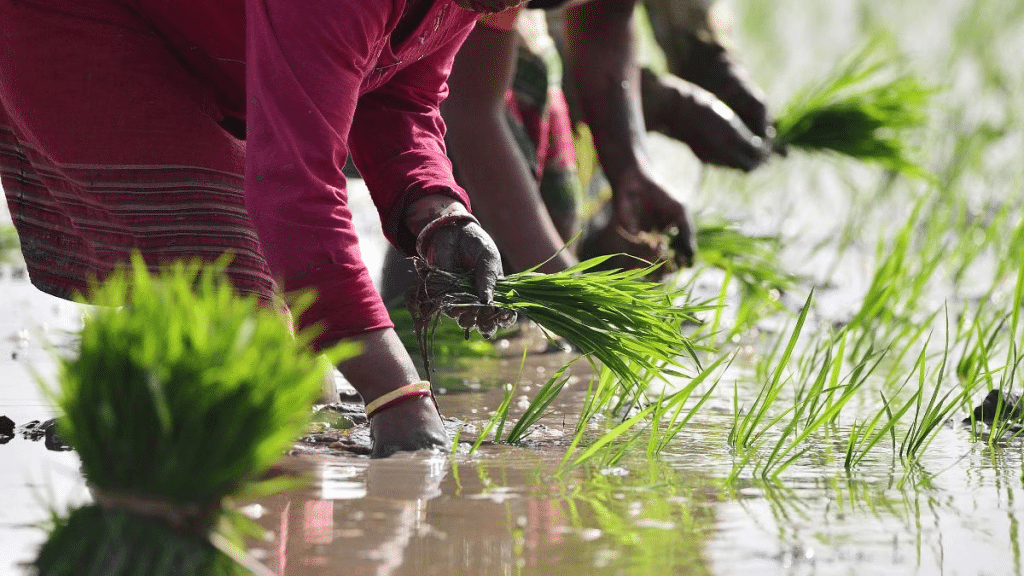Tags
Iron-fortified rice will lower anaemia in India. It has no known adverse effects
Fortification of rice, a staple in India, with iron, vitamin B12 and folic acid has the potential to reduce and even eliminate iron deficiency & anaemia in the country.

Fortified rice is one of the most cost-effective long-term solutions to enhance the health of the Indian population | Representational image | ANI
Large-scale change in a country’s nutritional status takes time, even years, but when safe and effective food-based strategies are implemented across the population, there is potential for sustained, long-term gains in their health and well-being.
Since the early 1900s, food fortification programmes have successfully delivered essential vitamins and minerals such as iron, iodine, and folic acid to large and diverse populations around the world. This approach has yielded benefits even in India, where iodine-fortified salt has dramatically reduced iodine deficiency disorders such as goitre.
While it is acknowledged that the consumption of nutrient-dense diverse diets should be the primary end goal to ensure better nutrition, food fortification has proven to be a safe and effective interim strategy for improving nutritional and health outcomes.
Food fortification is the addition of vitamins and minerals (micronutrients) to commonly consumed foods (salt, rice, wheat flour, oil) during processing to increase their nutritional value. Lately, resistance to food fortification, especially concerning the usefulness of fortified rice in addressing nutrient deficiencies, has escalated in India. Questions around the safety of fortified rice, which is not based on scientific evidence, have led to misinformation and are causing confusion in the minds of consumers and manufacturers of fortified rice. Misconceptions that government-distributed fortified rice is artificial, or ‘plastic’ rice have caused fear. Additionally, there are concerns that iron-fortified foods lead to overconsumption of micronutrients and can be harmful to people with genetic haemoglobin disorders, such as thalassemia. This claim has been researched and no danger of iron toxicity has been found. It is, therefore, important to address these concerns on the safety and effectiveness of fortified rice.
Naturally regulated
In India, iron deficiency and anaemia largely affect children and women of childbearing age, with some states, including Uttar Pradesh, Odisha, Madhya Pradesh, Bihar, having a prevalence as high as 50 per cent for anaemia, according to the recent National Family Health Survey (NFHS-5). Low consumption of iron-rich foods, poor absorption of iron from plant-based foods, and parasitic infections are common causes. Fortification of rice, a staple in India with iron, vitamin B12 and folic acid, has the potential to reduce and even eliminate over time iron deficiency and anaemia in the large rice-eating populations of India.
Studies conducted in India and elsewhere have demonstrated the effectiveness of fortified rice to manage anaemia and iron deficiency. Currently, fortified rice provided through the public distribution system (PDS) across the country contains 4.25 mg of iron, 0.125 micrograms of Vitamin B12, and 12.50 micrograms of folic acid per 100g of raw rice, which translates to about one-third of the micronutrients a person has to consume in a day from food sources.
The micronutrient levels in fortified rice are regulated by the Food Safety and Standards Authority of India (FSSAI) and are within the safe upper levels. Therefore, toxicity from consuming fortified rice is unlikely or even impossible and any concerns about adverse effects are unfounded. Additionally, iron is regulated at the site of absorption, which means that if someone is iron deficient, their body absorbs more iron from the food. If the body has adequate iron, you do not absorb iron from the food. This in-built mechanism prevents excess iron from getting into the body, thereby preventing toxicity.
No known adverse effects
As with any food-based strategy, fortifying food with vitamins and minerals results in small but steady gains in nutrition and health. JP Peña-Rosas and colleagues at the World Health Organization’s Department of Nutrition and Food Safety conducted a review of all the rice fortification studies currently published (17 studies across 10 countries) to assess the impact of rice fortification on anaemia, including iron deficiency.
A frequently cited statement from the WHO review is that rice fortification “may make little or no difference” in reducing the risk of anaemia among the population aged two years and beyond. The analysis of at least seven of the reviewed studies revealed a 3 per cent reduction in anaemia, and most studies were conducted for only six months, which may not be enough time to bring about a greater reduction in anaemia. Is this 3 per cent reduction of any consequence within the framework of rice fortification in India? The answer is yes. It aligns with the 2017 National Nutrition Strategy, which envisioned a 3 per cent annual reduction in anaemia.
The WHO review highlighted that the provision of rice fortified with vitamins and minerals, including iron, is likely to improve iron status by reducing the risk of iron deficiency by 35 per cent. When studying the effects of fortification, it is important to consider factors such as the levels of iron in fortified rice, the rate of iron absorption into the body, and the duration of the study. Seven of the studies in the WHO review featured a modest range of iron levels in rice (6.25-20mg per 100g), which resulted in increasing the average concentration of haemoglobin by almost 1.83g/L. The relatively low amount of iron in fortified rice (4.25mg/100g) used in India results in smaller changes, similar to the review findings.
A recent (unpublished) central government pilot study on rice fortification in Malkangiri, Odisha, further adds credence to the effectiveness of iron-fortified rice. The intervention led to a reduction of anaemia rates by 3.3 per cent in young children (six to 59 months), and by 6.3 per cent in women of reproductive age (15-49 years), with acceptance of fortified rice across 1.53 lakh households.
While the changes observed in the studies may seem moderate in terms of impact, this is entirely consistent with the expected outcomes of the fortification programmes as a preventive long-term approach. Additionally, there is no evidence of adverse effects reported in any of the earlier studies done globally. This should alleviate concerns about the safety of rice fortification. Nevertheless, as India expands large-scale food fortification, evaluating and monitoring for the occurrence of any adverse events is needed, and future research should systematically look into this aspect.
The other area of concern has been the consumption of fortified foods, particularly iron-fortified foods in those with haemoglobinopathies and blood disorders. For such individuals, at a population level, there exist no separate dietary intake guidelines and hence they follow the same dietary guidelines as those without these disorders. A recently released white paper by the Indian Council of Medical Research’s National Institute of Nutrition concluded that there was no evidence that consumption of iron-fortified foods by people with haemoglobinopathies led to adverse effects. Furthermore, the iron released from a blood transfusion, the treatment of such disorders, is several hundred-fold higher than the small amounts of iron coming from fortified food daily; therefore, it poses no greater harm.
In light of these findings and the broader context of India’s aspirations, rice fortification, within the context of India’s public health objectives, stands as a promising approach to combat micronutrient malnutrition. Fortified rice represents one of the most cost-effective long-term solutions, one that holds significant potential in the ongoing mission to enhance the health of the Indian population until we reach a point of adequate diet diversity that all can achieve.
Prashanth Thankachan is an associate professor of nutrition at St John’s Research Institute, Bangalore. Views are personal.
(Edited by Theres Sudeep)
https://theprint.in/opinion/iron-fortified-rice-will-lower-anaemia-in-india-it-has-no-known-adverse-effects/1926095/Published Date: January 16, 2024






